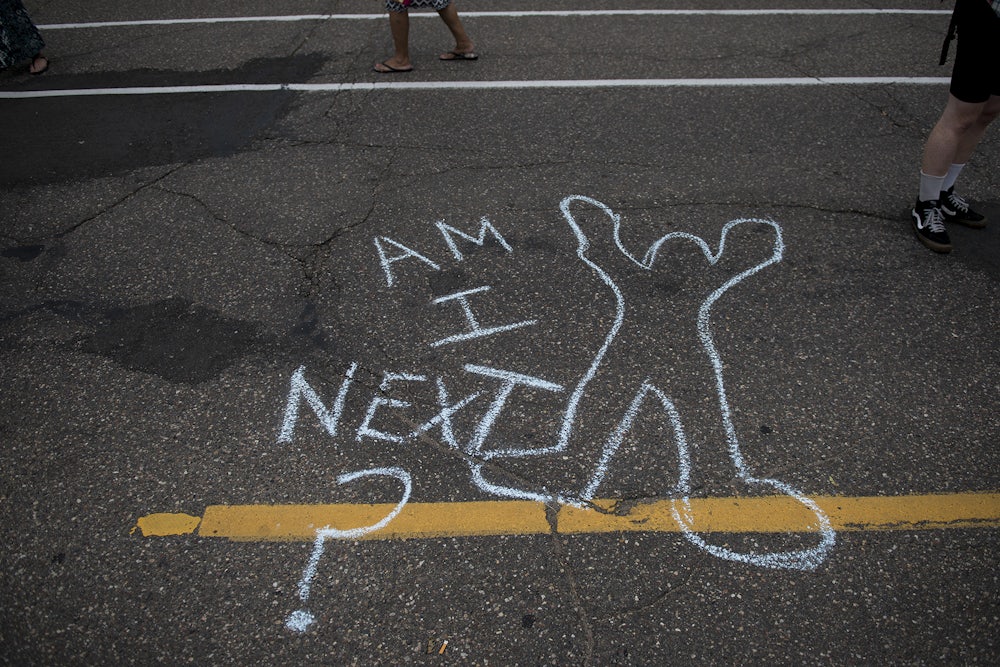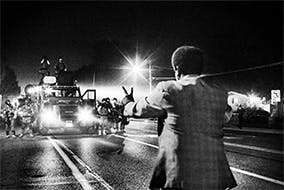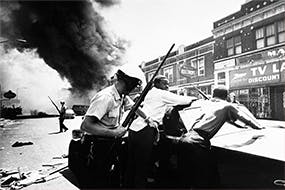Early one Friday morning, more than 250 police officers file into a high school auditorium in Elizabethtown, Pennsylvania. Dressed in the uniform of the off-duty cop—polo shirts and khakis accessorized with pistols and handcuffs—the officers are here to attend a seminar called “The Bulletproof Mind: Prevailing in Violent Encounters … and After.” As the cops settle into their seats, a burly National Guard sergeant in camouflage fatigues takes the floor to introduce the man who will lead the seminar: Lt. Col. Dave Grossman, a retired Army ranger and former West Point instructor.
A lean and energetic man, Grossman paces back and forth between two oversize pads of paper propped on easels. Equal parts motivational speaker, drill sergeant, and prophet of doom, he jabs the air with a fat permanent marker of the sort favored by graffiti artists. “We. Are. At. War,” he tells the officers, many of them from small towns in Pennsylvania. “And you are the frontline troops in this war. There is no elite unit showing up to save your bacon when the terrorists attack. You are the Delta Force. You are the Green Beret. You are British SAS. Can you accept that? Every single one of you is in the frontline of a live ammo combat patrol every day of your life.”
Sitting next to me, my father listens intently as he sips coffee. A retired cop who experienced his share of violent encounters during his 35 years on the Syracuse police force, he knows firsthand about being on the frontlines. He’s been thrown on the ground, pelted with rocks, threatened with power tools and knives, and shot at with a rifle. I’ve brought him to the seminar this morning to get his take on Grossman, the godfather of a controversial philosophy known as “warrior policing.”
The author of On Killing, a treatise on the psychological nature of military and police violence that has sold nearly 500,000 copies, Grossman is the world’s sole authority on “killology,” a scholarly field of his own invention that examines the factors that “enable and restrain killing” by soldiers and cops. For nearly two decades, he has taught tens of thousands of police officers, sheriff’s deputies, and federal agents in every state to cultivate what he calls a “warrior mindset”—being mentally prepared to kill at any moment. Grossman’s goal, in essence, is to get cops to think more like soldiers, training them to regard the communities they serve as territory occupied by potential insurgents.
Warrior training, and the martial mindset it advocates, has contributed to a string of high-profile police shootings of black citizens, intensifying national protests over police violence and the widespread use of military tactics and equipment by America’s police departments. Jeronimo Yanez, the police officer who shot and killed Philando Castile in front of his girlfriend and her four-year-old daughter during a routine traffic stop in a Minneapolis suburb last July, had attended a seminar on warrior policing co-taught by Grossman. Yanez shot Castile seven times, at point-blank range, because he mistakenly believed that Castile was reaching for the gun in his pocket instead of his wallet.
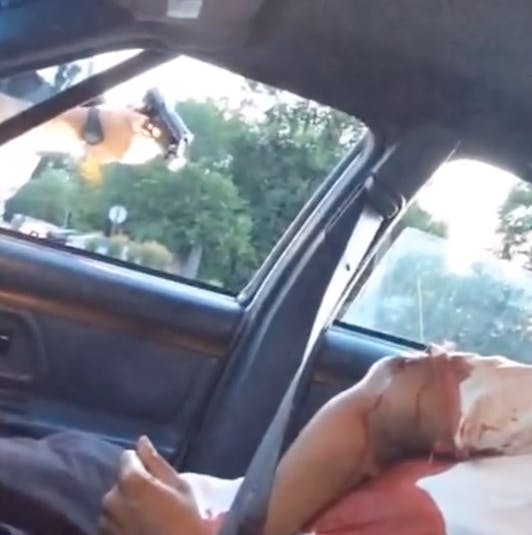
Calibre Press, an Illinois-based publisher of tactical training manuals for cops, organized the “Bulletproof Warrior” seminar that Yanez attended. In an online description that has since been taken down, Calibre promised students they would learn “how to utilize the ‘Warrior Spirit’ in a practical way so they can WIN hostile confrontations on the street.” When I emailed Grossman to ask him what this meant, he invited me to attend one of his own seminars to see what the warrior concept is all about.
Addressing the cops, Grossman makes the case for warrior policing. His voice rises as he paints a portrait of the United States as a crime-ridden dystopia. It’s a sturdy right-wing trope, not unlike the “American carnage” that President Trump evoked in his inaugural address. “Crazy bad times are upon us and it’s going to get a helluva lot worse,” Grossman warns. “Good news.” He chuckles. “You have job security. The world very desperately needs what you have to give.”
My father smiles wryly. Cops didn’t think of themselves as warriors in his day. But by the time he retired, in 1998, he had witnessed firsthand the seismic shift in policing that gave rise to the warrior cop. “The younger cops are a little different, you know,” he told me. “Christ, they pump fucking iron, got shaved heads, got fucking tattoos.” He likened them to Special Forces soldiers. “I think they’re being trained that way,” he added.
“You guys didn’t get trained like that?” I asked.
“No,” he said. “You were just an ordinary person that happened to be a cop. You weren’t out to conquer the fucking world. Just the assholes, that’s all.”
This is Grossman’s fifth presentation in as many days. He is on the road 300 days a year spreading the warrior gospel, because he believes that nothing less than the survival of our civilization depends upon it. “I get home one, maybe two nights a week,” he tells his audience, hitching his belt. “Conjugal visit, clean underwear, back on the road.” The assembled cops laugh. Then Grossman clasps the microphone close to his chest. “I have an intense sense of urgency,” he intones. “And I implore you to share this sense of urgency.”
The morning sessions contain a lot of Sturm und Drang delivered in a well-rehearsed, rapid-fire patter. “The murder rate exploded across America,” Grossman shouts, scribbling city names and percentages from 2015 on an easel. “An explosion of homicides like nothing we have seen since the American Civil War!”
Assertions like these, the kind that Trump deployed during his march to the White House, are misleading. Most of the increase in violent crime in 2015 was concentrated in just seven cities. Criminologists can’t explain precisely what fueled the spike in murders, but the uncertainty provides fertile ground for Grossman’s grim prescience. The future, he says, is mass murder. There will be massacres on school buses and in day-care centers, ultraviolence by Mexican drug cartels spilling over the border, the “systematic ambush, murder, and execution of cops,” ISIS-inspired butchery, September 11–scale terror attacks—and perhaps worst of all, in his estimation, the emergence of a “vicious generation of kids” raised on “the sickest movies and the sickest video games,” who will soon “give us crimes as adults we never dreamed of.”
During a break, we get up to stretch our legs. “He’s a little intense,” says my father, “but he’s 100 percent right.” He especially likes Grossman’s appraisal of Grand Theft Auto V, a video game my dad couldn’t distinguish from Super Mario Kart, as a “cop-killing murder simulator.”
Grossman stands at a table signing books and bantering with attendees. A woman with wavy blond hair tells him that she loves being a cop.
“Ain’t that a neat thing to say?” says Grossman, nodding in affirmation. “How many people go to work every day, take a bite of a dirt sandwich to make a living, and how many say they love what they do?”
“Yeah, couldn’t imagine doing anything else,” the woman says. “It’s a tough … a tough atmosphere.”
“Hoo-ah! It is a hard time!” Grossman finishes writing an inscription in her book, then reads it back to her. “Ecclesiastes 3:3: a time to kill, a time to heal.”

Grossman’s father was a police officer in Cheyenne, Wyoming for a short time in the 1960s before taking a job with Boeing as part of the government’s nuclear security program. The family moved every 18 months, following the trail of Minuteman missiles that were being installed throughout the Midwest in the 1960s. Grossman graduated high school at 17 and went to work in the Nebraska oil fields. It was grueling, dangerous work, and he quit after six months. Soon after he turned 18, he enlisted in the 82nd Airborne.
Grossman’s career as a “killologist” began with a simple yet profound question: What’s it like to kill another human being? After basic training, he expected to be shipped off to Vietnam. The Army had trained him how to kill, but he didn’t know what it would feel like. It was a taboo topic among combat veterans, and the war ended before he got a chance to find out for himself.
The Army sent Grossman to the University of Texas, where he earned his masters in education psychology. His thesis, On Killing, was published in 1995. In the book, Grossman makes the bold assertion that humans aren’t natural-born killers, but must be psychologically conditioned to overcome their innate inhibition against taking life. “If we understand how we can empower people to kill,” he says, “then we can understand how to turn it off, what signals to look for.” In 1998, after he retired from the military, he founded the Killology Research Group to focus full-time on writing and speaking.
His timing was perfect. The war on drugs—and later the war on terror—transformed police departments into paramilitary forces, spreading the warrior ethos to every corner of American law enforcement. Between 2002 and 2011, the Department of Homeland Security handed out $35 billion in grants to state and local police. At the same time, the Pentagon supplied surplus military gear—everything from assault rifles to armored personnel carriers with rotating turrets—to practically every police department in the country. Even small-town departments could now afford their own SWAT teams, whether or not they needed them. According to Peter Kraska, an expert in police militarization at Eastern Kentucky University, more than 80 percent of towns with fewer than 50,000 residents now have a SWAT team—and nationwide, such units are called out some 50,000 times a year, most often for raids on the homes of low-level drug offenders.
The military gear has been accompanied by a military mindset. Warrior training, like the kind offered by Grossman, seeks to instill cops with the same instincts as soldiers. “You gotta be on high alert, and you gotta look for any indices of threat, and you need to eliminate that threat, just like the military does, in a second,” says Kraska.
Law enforcement experts contend that warrior training helps prepare cops for a job where even a routine traffic stop can turn deadly in a matter of seconds. Nick Selby, a Dallas-area police detective and co-author of In Context: Understanding Police Killings of Unarmed Civilians, says warrior training likely prevents killings by giving officers the ability to control their fear and respond to deadly threats with lethal precision. “Warriors survive,” Selby says, “because they have the tactics, and the understanding of the dynamics, and they’ve trained enough that they can keep their wits about them when they have to think.”
The problem is, training police officers to think like warriors effectively alienates them from the communities they are sworn to protect. It can also lead them to perceive threats where none exist, escalating what should be minor conflicts into deadly force encounters. Along with a host of other policies that the criminal justice system has inflicted disproportionately on communities of color—stop and frisk, broken windows, three strikes—police shootings have fostered an atmosphere of deep distrust. Once cops started thinking like occupying troops, a clash like the one that followed the killing of Michael Brown in Ferguson, Missouri, became all but inevitable. “The angst against this sort of militaristic, overhyped policing has been growing for a long time,” Kraska says.
Grossman peppers his talk with examples of warriors worthy of emulation—laconic Spartans, noble knights, Batman. But his ideal warrior is the sheepdog, a symbol made famous by the blockbuster American Sniper. The dinner scene in the film where the father lectures his sons about the three types of people in the world—sheep, wolves, and sheepdogs—was based on a metaphor Grossman describes in his second treatise, On Combat: The Psychology and Physiology of Deadly Conflict in War and in Peace. Most people in society are harmless sheep, the theory goes; a small number are wolves that prey on the sheep; and an equally small number are sheepdogs that confront the wolves. The three types coexist in a circle of violence.
“Violence without empathy is a pretty good thumbnail definition of what? A psychopath, a sociopath—a wolf,” Grossman tells the cops in the auditorium. “But what if you have a propensity for violence, and a love for the lambs? What if you spent a lifetime nurturing the capacity for violence and the desire to use it in a righteous battle? Now what do you have? A sheepdog—a cop.”
The sheepdog also functions as Grossman’s brand. He co-teaches a series of sheepdog classes tailored for civilians, and sells a line of sheepdog custom weaponry through a side business run by his son, a master gunsmith. (The company’s mission: “to provide quality tools for our Sheepdogs to survive and thrive in these violent times.”)
The concept works on an almost subliminal level. When Grossman asks the cops in Elizabethtown what the sheepdog said when he first heard about the September 11 hijackings, a murmur ripples through the audience: I wish I was on that plane.
“I wish I was on that plane,” says Grossman, repeating the phrase. “Be ready in the mall, be ready in the theater, be ready in your house of worship.”
In On Combat, the sheepdog ideal of heroic sacrifice is democratic. Anyone can make the conscious decision to become a sheepdog. The doomed passengers on Flight 93, for instance, were ordinary sheep until they summoned the courage to rush the cockpit. In the clubby atmosphere of the seminar, though, where everyone identifies as a sheepdog, sheep are viewed as contemptible “grass eaters” that the sheepdogs grudgingly tolerate in between their Olympian battles with the wolves.
“You see, the sheep are always trying to pull you down,” says Grossman, exhorting the audience to train as hard as Batman. “The average citizen of Gotham City watches the news—crime, death, violence! What do they do? Hunker down, cry, lock the door.”
In this worldview, it is the wolf—not the sheep—that gives the sheepdog meaning and purpose. Grossman emphasizes this point when he tells the cops what they must do if confronted by a school siege like the 2004 massacre in Beslan, Russia, which left 186 children dead. “It is your job to put a chunk of steel in your fist and go in that door,” he growls, “and kill the sons of bitches who come to kill our kids and destroy our way of life!”
The sheepdog metaphor valorizes the warrior ethos: The sheepdog does not serve the flock, he protects it. But without the legitimacy conferred by the trust and consent of those being protected, protection is not policing—it’s occupation. “Frequently, the modern conception of policing is that cops are outside, or above, or separate from the community,” says Seth Stoughton, a law professor at the University of South Carolina and a former police officer. “That’s the whole idea of the ‘thin blue line.’ It’s the thing that separates society from chaos, but also separates cops from society.”
Stoughton argues that law enforcement’s “warrior problem” begins in the police academy. From day one, cadets have it drilled into them that everyone they encounter on the street could kill them at any second, and their training reinforces this fearful outlook. According to the Police Executive Research Forum, a law enforcement think tank, police recruits receive an average of 107 hours of training in firearms and defensive techniques, but only 16 hours in crisis intervention and de-escalating conflicts. Police departments also pay for officers to attend classes like Grossman’s as part of their “in-service” training. Given the emphasis on firearms over conflict resolution, which skill is an officer likely to fall back on when things get dicey?
What’s more, cops are now expected to handle potential threats that go far beyond walking a beat. Ever since the Columbine school massacre in 1999, police officers have had to prepare for the possibility of storming their local high school, and the attacks of September 11 put them on the frontline of combating terrorism. But while cops may sometimes need to rely on warrior skills, Stoughton says, orienting law enforcement around such low-probability, high-risk events is “counterproductive to good policing.”
The current debate over police reform is often presented as a false choice between two straw men: the aggressive, trigger-happy warrior versus the gentle guardian who thinks he can magically de-escalate every situation. It’s not useful to frame the debate exclusively in terms of use of force, because all police officers use force. A guardian’s response to an armed robbery will be no different from a warrior’s. What truly matters is the set of principles that guides an officer’s actions, whether it’s a traffic stop or a school shooting.
The guardian model is premised on cooperation and “protecting civilians from unnecessary indignity and harm,” says Stoughton. The warrior model is based on principles of compliance and control, which puts police in an adversarial relationship with the public. It’s the cop who threatens to use force on anyone who doesn’t follow his orders. Not only is such behavior alienating and provocative, it’s just bad policing. My father says he was always prepared to administer a “hickory shampoo” with his nightstick if the situation called for it, but he preferred to reason with people, even when they were noncompliant or aggressive. To many police officers of his generation, treating criminals like human beings instead of enemy combatants just seemed like common sense.
“It’s all in how you fucking talk to people,” he explains. “You’ve got to show them respect. You can’t be a fucking wise guy: ‘Well, I’m the police!’ It ain’t gonna work, because you’re making them hostile.”
Most situations officers face on a daily basis don’t call for warrior skills. Their default mode should therefore be guardian-like, and warrior-like only when necessary. But right now the polarities are reversed, and changing that will require an overhaul of police culture no less profound than the one that gave rise to the warrior cop.
“It’s not going to happen soon,” Stoughton says. “We’re talking about changing a profession’s self-identity.”
At lunchtime, I follow a line of cops to the cafeteria. Someone nudges my shoulder, and I turn around to see a young cop with a shaved head and a pistol on his hip scowling at me. “Hey buddy, who you work for?” he asks.
I explain that I’m a journalist. “I hate the media,” he says. “CNN, no go. Fox, yes.” I introduce him to another citizen of Fox Nation, my father, and quicken my pace.
Moments later, the cop sidles up to me again, a bottle of Mountain Dew sloshing in each hand.
“I can say this much,” he says. “When I grew up, I was that liberal kid. And when I got into this job—forget it.”
His name is John. He serves on the police force in Harrisburg, Pennsylvania, “a little capital with big-city problems,” he tells me. He likes pulling night shifts because “evil seeks darkness,” and vanquishing evil is a lot more fun than writing traffic tickets. Then he launches into a disjointed diatribe about the liberalizing agenda within law enforcement, media bias against cops, and the public’s ignorance of case law that “protects the police officer” from unfair scrutiny in use-of-force situations.
“Things are changing,” he says tersely. “Even police officers make mistakes, you know? Because we’re human.”
John’s defensiveness is common among police officers I’ve spoken to. Besieged by criticism over police shootings, they lash out at their perceived enemies, especially Black Lives Matter activists and the liberal media. It seems to them as if everyone is an armchair quarterback, questioning an officer’s split-second decisions based on snippets of viral video. Their frustration is understandable, but their defensiveness masks a darker assumption: that the public has no say in how they are policed. Grossman’s advice to his audience is to suck it up.
“There’s umpires and cameras everywhere,” he tells them. “We gotta win this game, gotta win by the rules, no other way. People say, ‘But the bad guys don’t play by the rules.’ That’s why he’s the bad guy! That’s why we all get together, we hunt him down like a dog, we fill him full of holes, we shove him in a cage like an animal—because he won’t play by the rules. If we don’t want to play by the rules, they’ve got a cage for us, too.”
But cops are playing by the rules—rules that favor them. Between 2004 and 2011, according to an analysis by The Wall Street Journal, officers were cleared of wrongdoing in more than 99 percent of fatal shootings. The problem isn’t that the shootings might have been legally justified—the problem is that they were often unnecessary. In a report released last year that caused an uproar in the law enforcement community, the Police Executive Research Forum refers to such shootings as “lawful but awful.” PERF recommends making de-escalation formal policy in the nation’s 18,000 police agencies and giving cops more training in how to defuse conflict without resorting to deadly force.
Grossman, for one, dismisses the report, arguing that cops are already being “force fed” this kind of guardian-oriented training. Many police officers denounce it as politically correct hokum that will get cops killed. They point to Graham v. Connor, the 1989 U.S. Supreme Court decision that ruled an officer’s use of force must be considered from the perspective of an objectively reasonable officer in the same circumstances, without the clarity of hindsight. That’s why cops hate being second-guessed by community activists and journalists, who in their eyes are ignoring this established legal standard.
PERF wants to hold police officers to a higher standard than Graham. In situations that don’t involve suspects armed with guns—roughly half of the 963 people killed by police last year—PERF says officers should be better trained to defuse conflicts, and to use force proportional to the threat they face, not simply force that’s justifiable.
When I ask my father how he resolved such issues during his years on the force, he gives me a perfect example of the kind of situation that PERF’s guidelines are designed to address. One day, responding to a call about a disturbance at a housing project, he and his partner confronted a man in a hallway brandishing a knife and a hammer. The man appeared to be mentally ill and ignored commands to drop the weapons. “He was crazier than shit,” my father recalls. “We gotta take him out of there, but he didn’t want to have anything to do with us. So now we know we gotta take him forcibly.”
This happened about 40 years ago, before street cops were issued body armor, Tasers, pepper spray, metal batons, or beanbag guns. So he and his partner decided to bum-rush the guy. They each chose a hand. My father volunteered to go for the knife.
But the standoff between my father and the crazy guy didn’t end with a dramatic struggle. Just as he and his partner were about to converge on the man, my dad tried reasoning with him one last time. He took what PERF calls a “tactical pause.”
“Look, sir,” he said to the man. “A lot of people are looking out of their doors here, and they think there’s something wrong. Can’t you just put your hand in your pocket with that knife? Put it in your pocket so they don’t see it. Then people won’t think there’s something wrong.”
The man lowered the knife and slid it into his pocket. In that instant my father and his partner grabbed the man and pinned his arms to his sides. No one was injured. No one died.
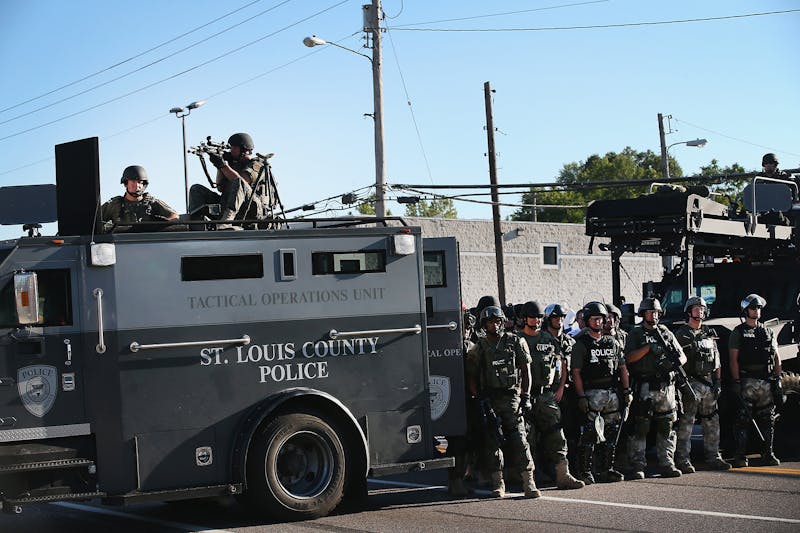
These days, cops rarely grapple with knife-wielding suspects. It’s too dangerous, and it’s contrary to the warrior mindset. In recent years, videos have emerged showing police officers in San Francisco, Albuquerque, and Chicago killing suspects holding knives. In 2010, a police officer in Seattle killed John Williams, a 50-year-old Native American wood-carver. Police dash-cam video of the incident shows Williams crossing the street in front of the officer’s car, carrying a piece of wood and a small knife. The officer gets out and pursues Williams around a corner, gun drawn. He shouts at Williams, who was deaf in one ear, to drop the knife. Then five shots ring out. The whole encounter lasts less than ten seconds.
Despite opposition from many police officials, PERF’s guidelines to curtail the use of excessive force have been endorsed by police departments in New York, Chicago, Baltimore, and elsewhere. And there are other signs that police culture is starting to shift away from the warrior model. Calibre Press, the company that pioneered warrior-policing tactics back in the 1980s, has eradicated the word warrior from its course listings and added new classes to align its curriculum more closely with reform trends. New offerings such as “The Guardians of Democracy” and “Balancing our Bias” read like chapter titles from a PERF report.
Grossman acknowledges the debate between guardians and warriors only when it allows him an opportunity to remind his audience of the warrior’s rightful claim on the soul of the American cop in these “dark and desperate times.” The symbol for his brand may be a sheepdog, but it’s a dog that favors the wolf’s instincts to fight over the sheep’s aversion to violence. “The definition of a warrior is one who is a master of what? War,” he tells the auditorium full of cops. “Is our nation at war? Are you the frontline troops in this war? The people screaming the loudest about never using that evil word warrior are going to look very, very foolish in the near future, do you understand?”
In Grossman’s view, warriors and guardians agree on one crucial point: Unlike soldiers, their mission is to avoid killing. “Our strength comes from that, our purity comes from that,” he says. “We must never fail to communicate that message. That’s what the guardian model is about. And they’re right—they’re very right. Treating people with dignity, without a doubt, is at the foundation of what we have to do. That’s what they lost track of in Ferguson.”
Three stories came out of Ferguson. The official story was that officer Darren Wilson fatally shot Michael Brown in self-defense after Brown assaulted him. A counter-narrative quickly emerged from witnesses who claimed that Brown was surrendering with his hands in the air when he was executed by Wilson. Less well-known is the third story, which was laid out seven months later in the Justice Department’s investigation of the shooting. The investigation confirmed the official story, but it also provided important context that explains why the counter-narrative took hold.
Witnesses didn’t come forward to refute the bogus execution story, for a simple reason: The community’s relationship with local police was totally broken. The Ferguson Police Department, the investigation found, had engaged in a “pattern of excessive force” against the city’s black residents, and “with extremely limited exceptions” all of the arrest warrants issued by the city’s municipal court were for unpaid parking tickets, housing code violations, missed court dates, fines, and other minor infractions. Police, judges, and city officials weren’t protecting or serving the citizens of Ferguson—they were systematically preying on them.
Grossman views Ferguson as a cautionary tale about what can happen when police officers violate the warrior’s code. “The social contract says you have the right to use deadly force,” he says. “But the moment that person is not a deadly force threat, their life is as precious as any other life on the planet.” After Wilson shot Brown, he tells his audience, the police made no effort to save Brown’s life. “Not one single person jumped on that body and gave chest compressions,” he says. “If somebody had even tried to take action—slap on a tourniquet, a couple of Band-Aids, doing chest compressions—it would’ve been a different story.”
Ferguson provoked national outrage over racism and police violence, launched a mass protest movement, and forced police departments to rethink the warrior model. But in Grossman’s view, all of that might have been avoided if one cop had performed CPR on Michael Brown’s dead body. After the seminar, I followed up with Grossman multiple times to clarify this point, but he stuck to his guns. As he sees it, the rising homicide rate, a recent spike in murders of police officers, and the election of Donald Trump have combined to discredit Black Lives Matter and others seeking to curb police violence.
“There’s going to be a backlash of enormous magnitude in the other direction,” Grossman predicts. “Back to broken windows, back to stop and frisk, back to cops in the street aggressively pursuing crime.”
To Grossman, serving as a police officer is ultimately about being willing to sacrifice oneself for others. It is a distinctly Christian ethos that he backs up with frequent Bible quotes and references to medieval times. His ideal cop is a modern Crusader in the eternal battle between good and evil, a paladin whose violence is sanctified by his higher purpose. Even if he kills the wrong person, a true warrior cop kills only for the purest of motives.
At the end of the seminar, Grossman uncaps two markers, bends toward the easel, and writes the word LOVE in large block letters on a fresh sheet of paper, underscoring it with a squiggly flourish. Then he turns to face his audience. Projected on the screen behind him is an image of Christopher Amoroso, a Port Authority police officer who died rescuing people on September 11.
“Only the sheepdog loves enough to die for other people’s loved ones,” Grossman says, his face lit by the ghostly glow of the projector. “You believe in who you are, you believe in what you do. For greater love hath no one than this.”
